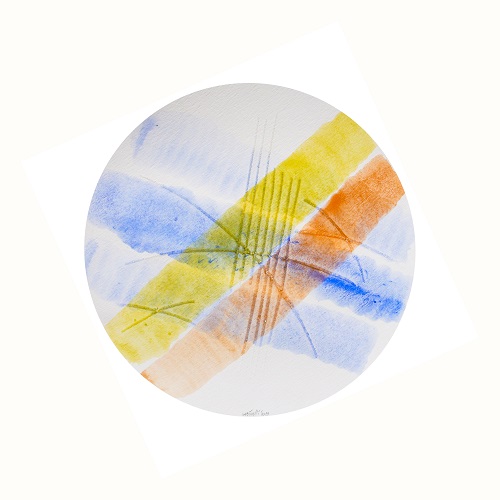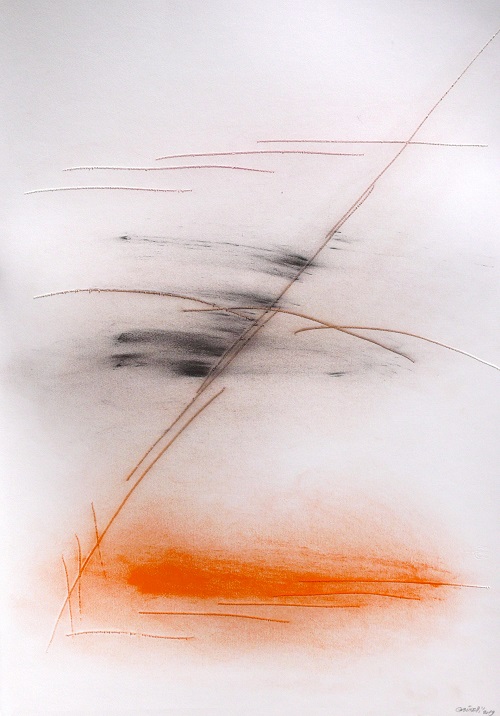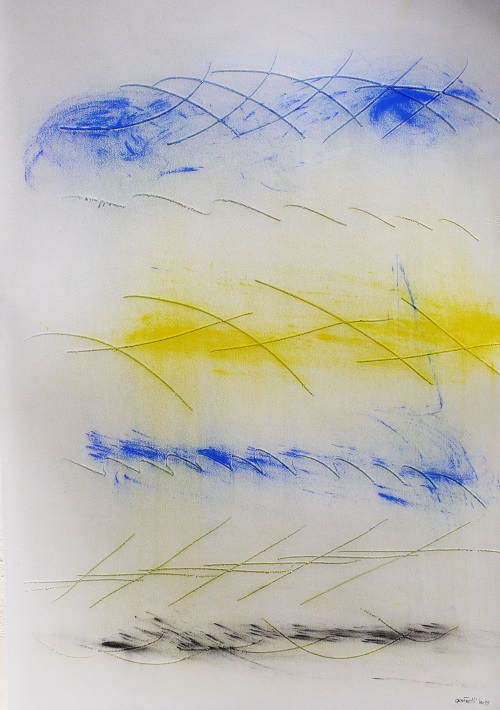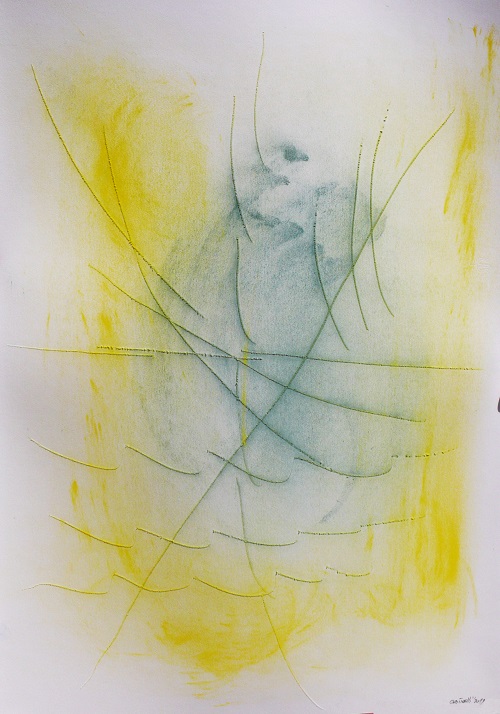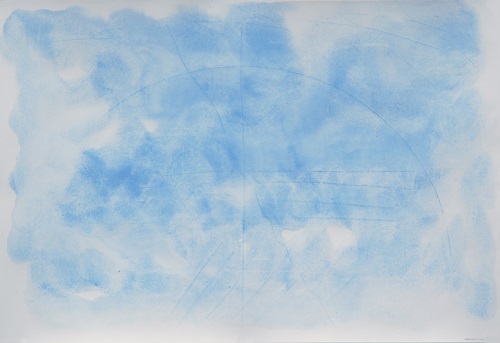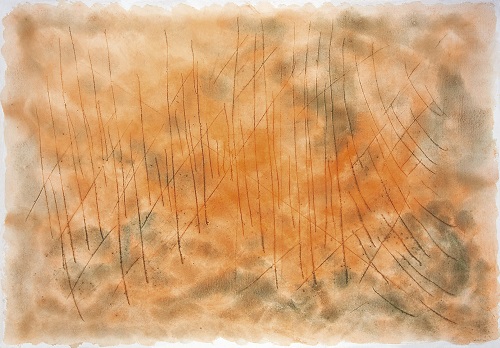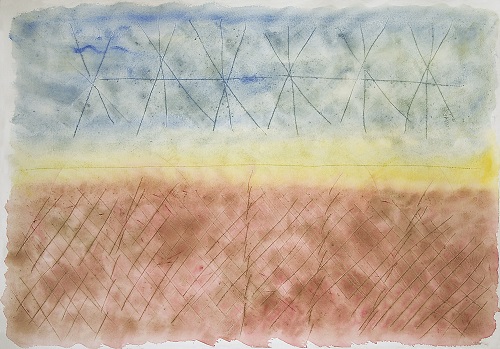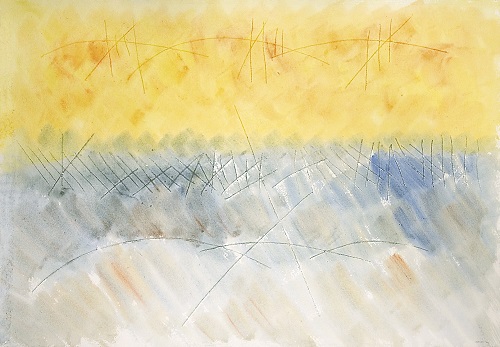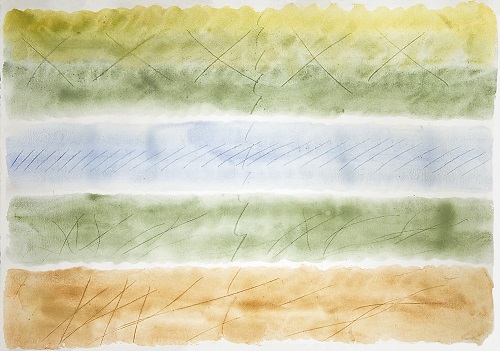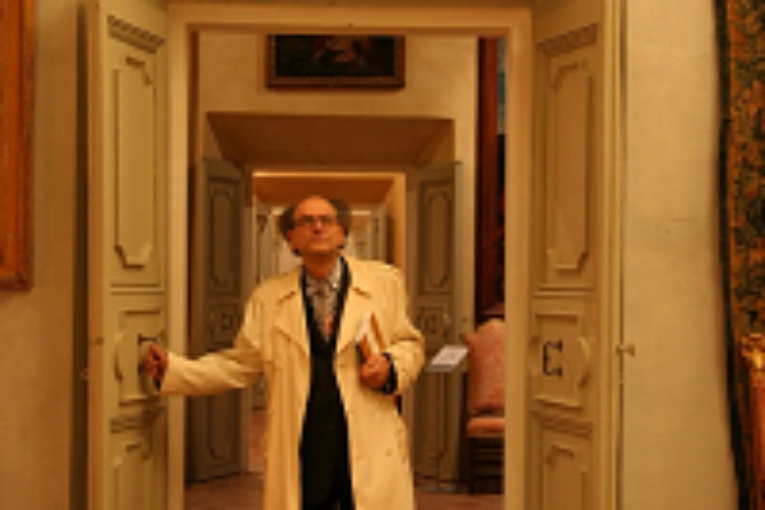
English version below Italian article
Le opere su carta del poeta dell’arte contemporanea, come è stato giustamente definito Paolo Gubinelli, sono capaci di trasmettere la profonda spiritualità e l’ancestrale sentimento mistico dell’artista. Si potrebbe inoltre affermare che l’istinto primario, il dono ricevuto, sia per Gubinelli quello di trovare dentro di sé e poi nel mondo che lo circonda la legge fondamentale dell’essere, ossia la Bellezza come equilibrio perfetto, kairòs donato all’umanità.
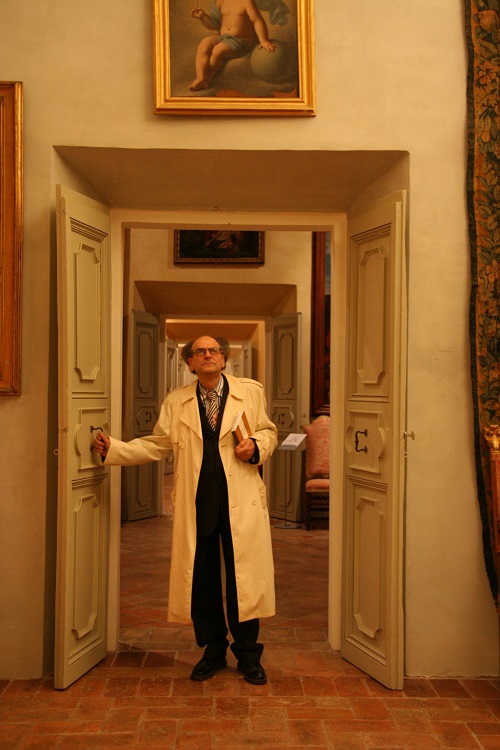
Tuttavia la sua Arte possiede anche un fil rouge con la musica e un particolare legame con alcuni grandi musicisti del passato. Questa peculiarità non è stata messa in evidenza dalla critica, che pure segue e studia meticolosamente la produzione del maestro individuando i rapporti intrattenuti con la poesia, non avendo preso nella giusta considerazione il percorso formativo di Gubinelli nato nel 1945 a Matelica, in provincia di Macerata, che annovera il Teatro comunale “Giuseppe Piermarini” dove Paolo fin da bambino avvia lo studio e la passione per la musica classica, iniziando a studiare fisarmonica all’età di cinque anni e clarinetto a dieci anni.
Soltanto il trasferimento in altre città italiane e l’avvio alla professione di pittore gli impediranno di frequentare il Conservatorio e diventare musicista professionista, ad ogni modo quell’iniziale bagaglio culturale è ritracciabile nella sua produzione pittorica. La musica, quindi, viene interpretata dal maestro nelle sue creazioni attraverso il segno mentale che unisce il pensiero di un nuovo linguaggio.
Come non riconoscere una convergenza elettiva tra Paolo Gubinelli e il compositore e pianista polacco Fryderyk Chopin(1810-1849): in entrambi l’accensione vibrante ed inquieta delle loro opere è una fiamma perennemente accesa. Lontani nel tempo ma vicini nell’esperienza umana di non essere compresi veramente dal loro tempo, di sentirsi a disagio in tutti i luoghi se non quello dell’anima.
Inoltre, nel ciclo dei Graffi, realizzati dal maestro marchigiano con colori in polvere su carta, il concetto di “spazio-luce” si articola nell’ambito di una approfondita ispezione, in cui il pittore tende a ridurre sempre più i mezzi e i modi operativi in una severa meditazione, diventando occasione per ripercorrere la miscellanea di emozioni tra inquietudine e armonie di una vita mutevole dove alle ombre si avvicendano le luci e alla notte si sostituisce il giorno, elementi che ritroviamo nella tenerezza totale diChopin, dove la Bellezza assolutizzante dell’emozione toccata nel suo intimo occupano lo spazio della sola nota infinitamente ribattuta nel Preludio n. 15 op. 28 (1831-1838), detto “la Goccia” perché suscita questa immagine. Chopin e Gubinelli hanno in comune la corda che sola batte nel cuore umano, insistente in mezzo alle avventure-sventure della vita, cioè il tocco della felicità cercata, la sublime emozione di averla un attimo non solo percepita, ma colta.
Anche il ciclo dei Cerchiincisi e colorati sulla carta da Gubinelli trasmettono Bellezza. Provenendo dai suoi studi sul rinascimento e dall’armonia classica di quelle forma perfette, posseggono un andamento di eleganza sinuosa, di purezza che appartiene a quegli artisti per i quali la Bellezza si esprime in modo totalizzante come lirismo puro, in questo richiamando il compositore e musicista austriaco Wolfgang Amadeus Mozart (1756-1791) che considerava la Bellezza il valore più alto e assoluto, ricerca anche faticosa, ma accolta come fosse un dono del cielo.
Chi ammira le ceramiche, come quelle esposte in permanenza alla pinacoteca comunale “R. Fidanza” della città di Matelica, i rilievi in vetro e le porcellana, i frottage su carta plastificata trasparente e le incisioni su plexiglass di Gubinelli, non avrà difficoltà a cogliere nelle opere la stessa atmosfera religiosa che si avvicina alla produzione di Johann Sebastian Bach (1685-1750) e in particolare alla Passione secondo Matteo. Un poema grandioso e commovente, dove si rintraccia una umanità che rivive il dramma di Cristo, non in modo singolo bensì corale, unitario. Una realtà che penetra nelle singole arie, nei recitativi appassionati, trovando sfogo in corali di temperatura spirituale ed emotiva altissima. Questa caratteristica si ritrova in un altro capolavoro bachiano, il Magnificat (1728-1731) in cui ancora una volta solisti e coro si alternano e si uniscono, formando uno splendore così bello come la stella del mattino, simbolo mariano.
L’atmosfera religiosa di Gubinelli si rintraccia anche in alcuni risultati del giovane Mozart, ad esempio nella musica sacra: la melodia purissima, ascendente del Laudate Dominum, di una bellezza “angelica”, e la luminosa, chiara Messa dell’Incoronazione (1779) con il canto dell’Agnus Dei, talmente ricco di palpitazione come momento di interiorità. E’ infatti una musica dell’anima, scesa come ispirazione limpida quasi da un cielo. Entrambi i maestri appartengono alla schiera degli artisti puri, come Angelico e Botticelli in campo pittorico, Chopin, Schubert e Pergolesi in campo musicale.
Nel ciclo delle Incisioni e piegature su carta bianca, dopo una intensa meditazione maturata nel silenzio e nel riserbo, Gubinelli elabora calibrate e ripetitive misure che ritmano lo spazio-tempo del foglio nell’atto incisorio, manifestando anche una monocromia armoniosa priva di addizioni cromatiche, di texture dove l’antinomia dell’ombra e della luce realizza un’entità spaziale.
Si veda ad esempio Installazione, N. 10 carte, cm 100×700 del 1977; Progressione analitica interattiva del 1979; Grande rotolo su carta trasparente del 1979, dove le ripetitive incisioni e piegature su carta bianca di Gubinelli, ma in altre opere anche su tela o su vetro, ci riportano ai Canti Gregoriani interpretati a cappella, senza accompagnamento strumentale, poiché ogni armonizzazione, anche minima, altera la struttura di questa armonizzazione. Si tratta cioè di un canto omofono, più precisamente monodico, essendo una musica che elimina la simultaneità sonora di diverse note: ogni voce che lo esegue canta all’unisono.
Tuttavia le piegature manuali del supporto concepite da Gubinelli, appena percepibili all’occhio e al tatto, ci trasmettono una “luce divina” e una spazialità sensibile che ci riporta alle monumentali Messe, come la Missa Papae Marcelli di Pierluigi da Palestrina. Le corrispondenze tra i due personaggi iniziano fin dall’adolescenza, entrambi enfant prodige. Nel 1544, a soli diciannove anni, Pierluigi fu assunto quale organista e maestro di canto nella cattedrale della sua città natale, Palestrina, con contratto a vita, rimanendovi però solo sette anni, durante i quali si dedicò intensamente alla composizione. Paolo a venti anni si trasferisce a Milano, affermandosi immediatamente nel campo della grafica, della progettazione architettonica e delle arti figurative, con la conoscenza di Lucio Fontana e i contatti continui con Bruno Munari a cui lo lega una grande amicizia e partecipando alle stesse mostre collettive.
Il dualismo che definisce il rapporto tra materia e forma, questa strutturale linea che attraversa l’intera storia del pensiero, costituisce l’asse intorno a cui Paolo Gubinelli ha declinato l’evoluzione della sua ricerca, proiettandovi una personalità tesa alla composizione di un sentimento ancestrale e puro del mondo e di un’altrettanto naturale propensione per l’euritmia geometrica. Quel suo fare è disposto a secondare pulsioni immaginative che sempre più chiaramente portano a impreviste strutturali formazioni, cariche di riferimenti etici e psicologici, forte di densità evocativa, in un circuito diretto fra memoria, immaginazione, emozione.
English version
PAOLO GUBINELLI
ELECTIVE CONVERGENCES BETWEEN ART AND MUSIC
by Roberto Luciani
The works on card of the poet of contemporary art, as Paolo Gubinelli has rightly been described, are capable of transmitting the deep spirituality and the ancestral mystic sentiment of the artist. It could also be said that the primary instinct, the received gift, is for Gubinelli that of finding within himself and then in the world around him the fundamental law of being, namely Beauty as perfect balance, kairòs given to humanity.
However, his Art also has a fil rouge with music and a particular bond with certain great musicians of the past. This peculiarity has not been brought out by the critics, who meticulously follow and study the master's production by identifying the relationships entertained with poetry, without taking into consideration the formative path of Gubinelli born in 1945 in Matelica in the province of Macerata, which includes the Municipal Theatre “Giuseppe Piermarini” where Paolo began his study of and passion for classical music as a child, starting to study the accordion at the age of five and the clarinet at ten.
Only relocation to other Italian cities and entering the profession of painter stood in the way of him attending the Conservatory and becoming a professional musician, in any case that initial cultural background is discernible in his pictorial production. Music, therefore, is interpreted by the master in his creations through the mental sign that unites the thought of a new language. How can we not recognize an elective convergence between Paolo Gubinelli and the Polish composer and pianist Frédéric Chopin (1810-1849): in both the vibrant and restless illumination of their works is a perpetually burning flame. Far apart in time but close in the human experience of not being truly understood by their era, of feeling uncomfortable in all places except that of the soul.
Furthermore, in the Graffi cycle, produced by our master from the Marche using powder colours on paper, the concept of "space-light" is articulated by an in-depth inspection, in which the painter tends to increasingly reduce operative means and methods in a severe meditation, becoming an opportunity to retrace the gamut of emotions between restlessness and the harmonies of a changing life where shadows alternate with light and night is replaced by day, elements that we find in the complete tenderness of Chopin, where the absolutizing beauty of emotion touched in its depths occupy the space of the single note infinitely repeated in the Prelude n. 15 op. 28 (1831-1838), called “the Raindrop” because it arouses this image. Chopin and Gubinelli have in common the chord that only beats in the human heart, insistent throughout life's adventures-misfortunes, that is, the touch of sought-after happiness, the sublime emotion of having it not only perceived, but also for a moment grasped.
The Circles cycle, engraved and coloured on paper by Gubinelli also conveys Beauty. Coming from his studies of the Renaissance and from the classical harmony of those perfect forms, the works contain a trend of sinuous elegance, of purity that belongs to those artists for whom Beauty expresses itself in a totalizing way as pure lyricism, here recalling the composer and Austrian musician Wolfgang Amadeus Mozart (1756-1791) who considered Beauty to be the highest and most absolute value, whose search was also tiring, but welcomed as if it were a gift from heaven.
Those who admire Gubinelli's ceramics, such as those permanently exhibited at the municipal art gallery “R. Fidanza" in the city of Matelica, his reliefs in glass and porcelain, his frottage on transparent plasticized paper and his engravings on plexiglass will have no difficulty in grasping the same religious atmosphere as in the works of Johann Sebastian Bach (1685-1750) and in particular to the St. Matthew Passion. A grandiose and moving poem, which traces a humanity that relives the drama of Christ, not in a single voice but in a choral, unitary way. A reality that penetrates into individual arias, into passionate recitatives, finding outlet in chorales of very high spiritual and emotional temperature. This characteristic is found in another Bach masterpiece, the Magnificat (1728-1731) in which once again soloists and choir alternate and unite, forming a splendour as beautiful as the morning star, a Marian symbol.
Gubinelli's religious atmosphere can also be found in some of the young Mozart'soutput, for example in sacred music: the purest, ascending melody of the Laudate Dominum, of an "angelic" beauty, and the luminous, clear Coronation Mass (1779) with the song of the Agnus Dei, as full of heartbeat as a moment of interiority. It is in fact a music of the soul, descended as a clear inspiration almost as from heaven. Both masters belong to the ranks of pure artists, such as Angelico and Botticelli in the pictorial field, Chopin, Schubert and Pergolesi in the musical field In his Engravings and Folds on White Paper cycle, after an intense meditation matured in withdrawal and silence, Gubinelli develops calibrated and repetitive measures that rhythm the space-time of the sheet in the engraving act, also showing a harmonious monochrome devoid of chromatic additions, of textures where the antinomy of shadow and light creates a spatial entity. Consider, for example, Installation, 10 cards, 100x700cm from 1977, Interactive analytic progression of 1979, Large scroll on transparent paper from 1979, where Gubinelli's repetitive engravings and folds on white paper, but in other works also on canvas or glass, resonate of Gregorian Chants interpreted a cappella, without instrumental accompaniment, since every harmonization, even minimal, alters the structure of the harmonization itself. It is a homophonic song, more precisely monodic, being music that eliminates the simultaneity of different notes: each voice that performs it sings in unison. However, the manual folds of the material conceived by Gubinelli, barely perceptible to the eye and touch, transmit a "divine light" and a sensitive spatiality that brings us back to the monumental Masses, such as Pierluigi da Palestrina's Missa Papae Marcelli. The correspondences between da Palestrina and Gubinelli begin as early as adolescence, both enfant prodige. In 1544, at only nineteen, Pierluigi was hired as organist and singing teacher in the cathedral of his hometown, Palestrina, with a lifetime contract, remaining there however only seven years during which he devoted himself intensely to composition. At the age of twenty Paolo moved to Milan, immediately establishing himself in the field of graphics, architectural design and figurative arts, with the company of Lucio Fontana and continuous contacts with Bruno Munari, with whom has a great friendship and participates in the same collective exhibitions. The dualism that defines the relationship between matter and form, this structural line that traverses the entire history of thought, constitutes the axis around which Paolo Gubinelli has declined the evolution of his research, projecting onto it a personality aimed at the composition of an ancestral and pure feeling of the world and of an equally natural propensity for geometric eurhythmy. His work tends to reinforce imaginative impulses which ever more clearly lead to unexpected structural formations, full of ethical and psychological references, strong in evocative density, in a direct circuit between memory, imagination and emotion. In “2 Learning Advanced”, 13 December 2020, http://www.2la.it/in-evidenza/6067-paolo-gubinelli-convergenze-elettive-tra-arte-e-musica/
English translation by Derek Ian Barnes
© 2la.it - Riproduzione riservata.



